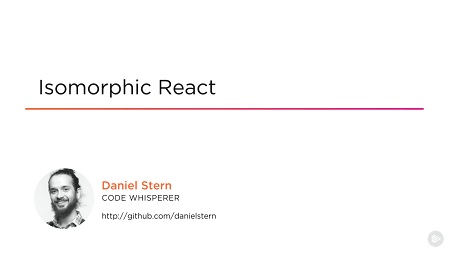
English | MP4 | AVC 1280×720 | AAC 44KHz 2ch | 2h 44m | 407 MB
This course will teach you how to build high-performance and secure isomorphic React applications.
Reducing user latency and increasing security are just a few of the reasons for why React is such a tremendous tool for isomorphic rendering. In this course, Isomorphic React, you’ll learn how to build an isomorphic React application from start to finish. First, you’ll learn what isomorphic code is and link this idea to React. Next, you’ll explore the specific isomorphic features of React, including the ReactDOM library. Finally you’ll create a flexible isomorphic foundation upon which you will build a React application. When you’re finished with this course, you’ll have a solid understanding of the React framework.
Table of Contents
01 – Course Overview
02 – Introduction
03 – Application Goals
04 – Finished Application – Sneak Peek
05 – Required Technology
06 – What We Won’t Be Covering
07 – Get the Course Files Here!
08 – Architecture Selection
09 – Course Roadmap
10 – Troubleshooting
11 – Introduction _ Understanding Isomorphic Code
12 – Isomorphic Process
13 – Advantages of Isomorphism
14 – Pitfalls and Challenges of Isomorphism
15 – Priorities of Isomorphic Applications
16 – Module Summary
17 – Introduction
18 – Major Libraries
19 – Data Injection _ Server-side Rendering
20 – React DOM Server
21 – React Router
22 – Hot Module Replacement
23 – Module Summary
24 – Setting up the Project Directory
25 – Configuring Babel
26 – Setting up Express
27 – Integrating Webpack with Express
28 – Implementing Webpack
29 – Adding API Routes and Mock Data
30 – Module Summary
31 – Adding React
32 – Implementing Redux & React-redux
33 – Adding Redux Saga
34 – Creating Dynamic React Components
35 – Adding Hot Reloading
36 – Implementing Server Rendering
37 – Adding React Router Part I – The Client
38 – Adding React Router Part II – The Server
39 – Module Summary
40 – Fetching Data for Multiple Isomorphic Routes
41 – Adding Production Settings
42 – Final Application Review
43 – Challenge Tasks
44 – Strategies for Continued Learning
45 – Thank You!
Resolve the captcha to access the links!